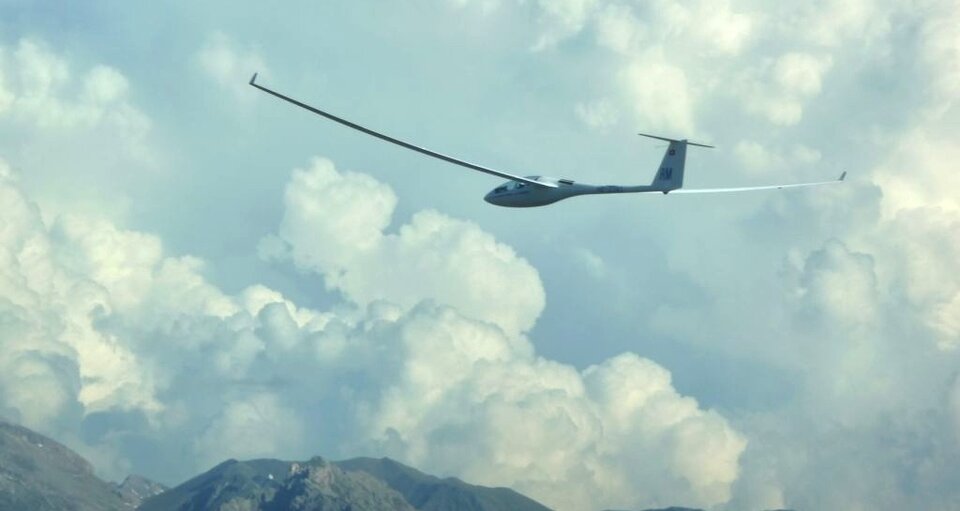How the wind blows

Thanks to the technology developed under the guidance of BI visiting professor Heinrich Meyr, the wish of many glider pilots for a precise real-time display of the wind characteristics could soon come true. In its March/April issue, the "Segelfliegen Magazin" explains in detail how a new type of variometer could soon make flying safer and even more enjoyable. Variometer is used to inform the glider pilots about the rate of descent or climb. The researchers used an algorithm based on a three-dimensional wind triangle and developed the matching hardware HAWK consisting of a microprocessor and a sensor unit. Their idea is just making the leap from research to industrial production. We give an overview of the concept below.
Gliding has fulfilled our ancient dream of flying. The glider pilot is not assisted in her flight by any motorized propulsion at all. She must rely entirely on her own skills - the surrounding winds and her ability alone can keep the glider in the air. Besides courage, this requires a great deal of technical understanding of weather conditions, thermal flow and the physics of flight.
The gliding sport is not without risk, because wind conditions can change quickly. Glider pilots must always be informed about the prevailing conditions. Otherwise, they would expose themselves to unnecessary danger. A particular challenge is the handling of the variometer. The instrument is the central tool for detecting and efficiently exploiting updrafts or for indicating undesirable downdrafts, so that they can be flown through quickly. Glider pilots depend on their variometer. For their own safety it is imperative, that they correctly assess the movement of air masses. Even though currently available Total Energy Compensated Variometers (TEK Varios) are accurate devices, there are certain situations in which they fail. For example, if a horizontal gust hits the glider, the TEK Vario will misinterpret this as a sink or rise. Experienced pilots have learned to deal with this inaccuracy of their variometer. They calculate the deviation themselves. Nevertheless, this systematic error leads to accidents. For example, if the wind current unexpectedly breaks off (stall) on a slope under gusty conditions, it can quickly become life-threatening. For this reason, pilots have long wished for an accurate real-time display of the wind characteristics, so that they know exactly, how the air masses around them are moving.
Prof. Heinrich Meyr, visiting professor at the Barkhausen Institute, and Dipl.-Ing. Peng Huang, member of the Vodafone Chair at the TU Dresden, have tackled the problem and completely rethought the measurement method on which the variometer is based. Their development eliminates the previous weak point, namely the magnetic sensor, which is susceptible to interference. The researchers created a completely new three-dimensional wind model and designed an algorithm for it, that provides the most accurate wind indication possible for all three dimensions in space. This makes it possible to measure wind with second-by-second accuracy. To enable their technology to be used in gliding, the researchers also developed the so-called HAWK unit, consisting of a microprocessor and a sensor box. The microprocessor runs a mathematical model, that calculates in real time the movement of the glider, the movement of the air and the deviations of the sensors. The model contains all important state variables, such as position, air speed relative to the ground, wind speed. In addition to GPS, the sensor box contains a number of sensors that determine the acceleration, the change in angle and the static and dynamic pressure. Currently, HAWK prototype is running on LXNAV's S10/S100 platforms and will be available on LX 9000 units later this year.
Pilots who already had the opportunity to test HAWK in the past year have expressed their enthusiasm. HAWK would be able to prevent the unexpected stall described above. It knows the position of the aircraft in space and controls the so-called angle of attack. If this becomes too large, the device can issue a warning to the pilot and minimize risks. In addition, the significantly higher precision may open up new possibilities for glider pilots in the future. Particularly in mountain flying, slope and wave flying, pilots appreciate wind information, which is accurate to the second. But wind information is also very important in less demanding conditions. Pilots can use the information provided by the HAWK, to find thermals in a targeted manner and thus optimize their flight. This makes flying even more enjoyable.
In addition to its specific use in gliding, this new technology could also be applied to networked unmanned drones for example. Among other applications, these drones will be used in the transportation sector in the future. They could also take over tasks on modern construction sites such as spraying facades or installing insulation. In the field of the Internet of Things, on whose trustworthiness BI is researching, the HAWK could therefore have even broader usage.
